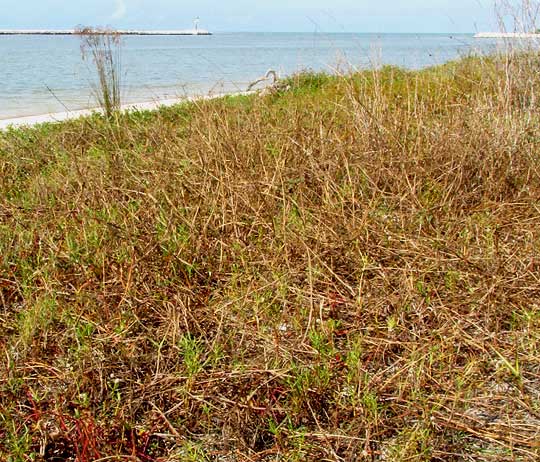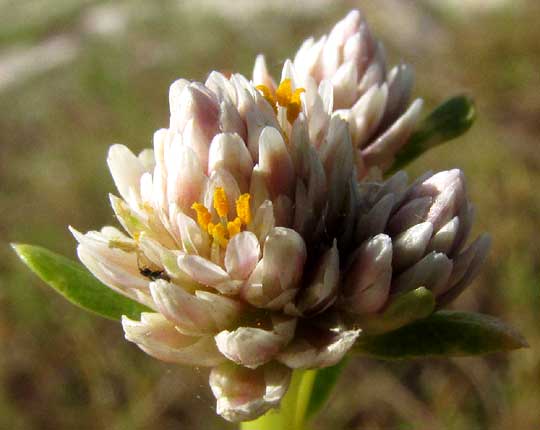Excerpts from Jim Conrad's
Naturalist Newsletter
from the January 25, 2015 Newsletter issued from Río Lagartos, on the Yucatan Peninsula's northern coast (~N21.60°, ~W88.16°), Yucatán state, MÉXICO
SALTWEED
Below you can see the weedy banks of the man-made canal cutting through the thin finger of land separating the estuary from the Gulf of Mexico right across the water from Río Lagartos:

That scruffy-looking vegetation is dominated by a leggy, sprawling, much branching herb with stems currently tipped with small, silvery, egg-shaped flowering heads, as shown below:

The egg-shaped, silvery flowering heads immediately put us in mind of certain genera of the Amaranth Family, especially the genus Alternanthera. For example, you might remember the Yellow Joyweed growing on the back of the church at Hacienda Chichen, shown at www.backyardnature.net/yucatan/joyweed.htm.
In fact, I was pretty sure that our canal weed was another Alternanthera species until I "did the botany." It turns out that taxonomists won't permit our sprawling herb entry into that large and well known genus because its flowering heads are subtended by two fleshy leaves, as shown below:

Alternanthera flowering heads are on long, leafless stems, or peduncles, as you can confirm in our Yellow Joyweed pictures.
Our plant belongs to a genus I'd never heard of, Blutaparon, a small genus of only four species, all the species found only in the tropical and subtropical Americas, and all inhabiting the littoral zone. The littoral zone is basically the area between low and high tide, though other definitions take it a little farther inland.
Our rangy-looking plant is BLUTAPARON VERMICULARE, variously known as Saltweed, Silverweed, Silverhead, Samphire, and other such names. It occurs on saline soils, sands of beaches, dunes and sand bars from southern Florida, southern Louisiana and Texas south to Brazil, plus the Caribbean area, and here and there elsewhere, such as Hawaii and Africa, where it shows up unexpectedly.
Happily, Saltweed doesn't need to appeal to human aesthetics in order to protect the shoreline from erosion, something that helps not only the mangrove ecosystem to stay intact, but also helps keep the estuary from filling with silt.